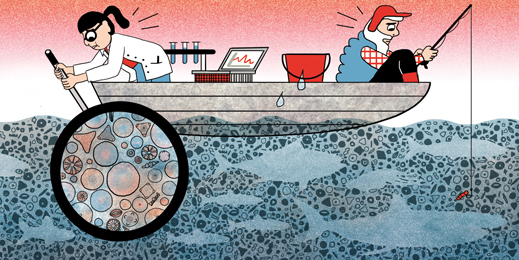Oceans have absorbed and stored up to 30 percent of human-generated carbon dioxide around the world. As the uptake of carbon dioxide has increased in the last century, so has the acidity of oceans worldwide.

Now an MIT-led team has found that ocean acidification will dramatically affect global populations of phytoplankton—microörganisms living near the ocean surface that make up the base of the marine food chain.
In a study published in Nature Climate Change, the researchers report that the increased ocean acidity expected by 2100 will spur a range of responses in phytoplankton: some species may become extinct while others will flourish, changing the balance of plankton species around the world.
Stephanie Dutkiewicz, a principal research scientist in MIT’s Center for Global Change Science, says that while scientists have suspected ocean acidification might affect marine populations, the group’s results suggest a much larger upheaval for phytoplankton—and therefore probably for the species that feed on them—than previously estimated.
“I try not to be an alarmist,” says Dutkiewicz, who is the paper’s lead author. “But I was actually quite shocked by the results. The fact that there are so many different possible changes—that different phytoplankton respond differently—means there might be some quite traumatic changes in the communities over the course of the 21st century.”
To get a sense for how individual species of phytoplankton react to a more acidic environment, the team performed a meta-analysis, compiling data from 49 papers in which others have studied how single species grow at lower pH levels. The researchers divided the species into six groups, based on biological criteria, and found a whole range of responses to increasing acidity, even within groups. Some “winners” grew faster than normal, while other “losers” grew more slowly.
The researchers then worked the experimental data into a global ocean circulation model to see how multiple species’ responses to rising acidity levels changed the natural competition between them. Dutkiewicz says shifting competition at the plankton level may have big ramifications further up in the food chain.
“Generally, a polar bear eats things that start feeding on a diatom and is probably not fed by something that feeds on Prochlorococcus, for example,” she says. If, for instance, rising acidity levels wipe out a large portion of diatoms, “the whole food chain is going to be different.”
The model also predicts that warmer waters may cause many phytoplankton species to move toward the poles.
“If you went to Boston Harbor and pulled up a cup of water and looked under a microscope, you’d see very different species later on,” Dutkiewicz says. “By 2100, you’d see ones that were living maybe closer to North Carolina now, up near Boston.”
Keep Reading
Most Popular
Large language models can do jaw-dropping things. But nobody knows exactly why.
And that's a problem. Figuring it out is one of the biggest scientific puzzles of our time and a crucial step towards controlling more powerful future models.
The problem with plug-in hybrids? Their drivers.
Plug-in hybrids are often sold as a transition to EVs, but new data from Europe shows we’re still underestimating the emissions they produce.
How scientists traced a mysterious covid case back to six toilets
When wastewater surveillance turns into a hunt for a single infected individual, the ethics get tricky.
Google DeepMind’s new generative model makes Super Mario–like games from scratch
Genie learns how to control games by watching hours and hours of video. It could help train next-gen robots too.
Stay connected
Get the latest updates from
MIT Technology Review
Discover special offers, top stories, upcoming events, and more.